Page 20 of 361
Downloaded from www.Manualslib.com manuals search engine Here you’ll find information about the seats in your Cadillac and how to use your safety belts properly. You can also
learn about some things you should 12ot do with air bags and safety belts.
1-2
1-8
1-12
1-13
1-13
1-20
1-21
1-21
Seats and Seat Controls
Safety Belts: They’re for Everyone
Here Are Questions
Many People Ask About
Safety Belts
-- and the Answers
HOW to Wear Safety Belts Properly
Driver Position Safety Belt
Use During Pregnancy
Right Front Passenger Position Supplemental Inflatable
Restraint
(SN) System
1-27
1 -30
1-3 1
1-33
1-40
1-43
1-43
1-43 Rear Seat Passengers
Center Passenger Position
Children
Child Restraints
Larger Children
Safety Belt Extender
Checking Your Restraint Systems
Replacing Restraint System
Parts After
a Crash
Page 32 of 361
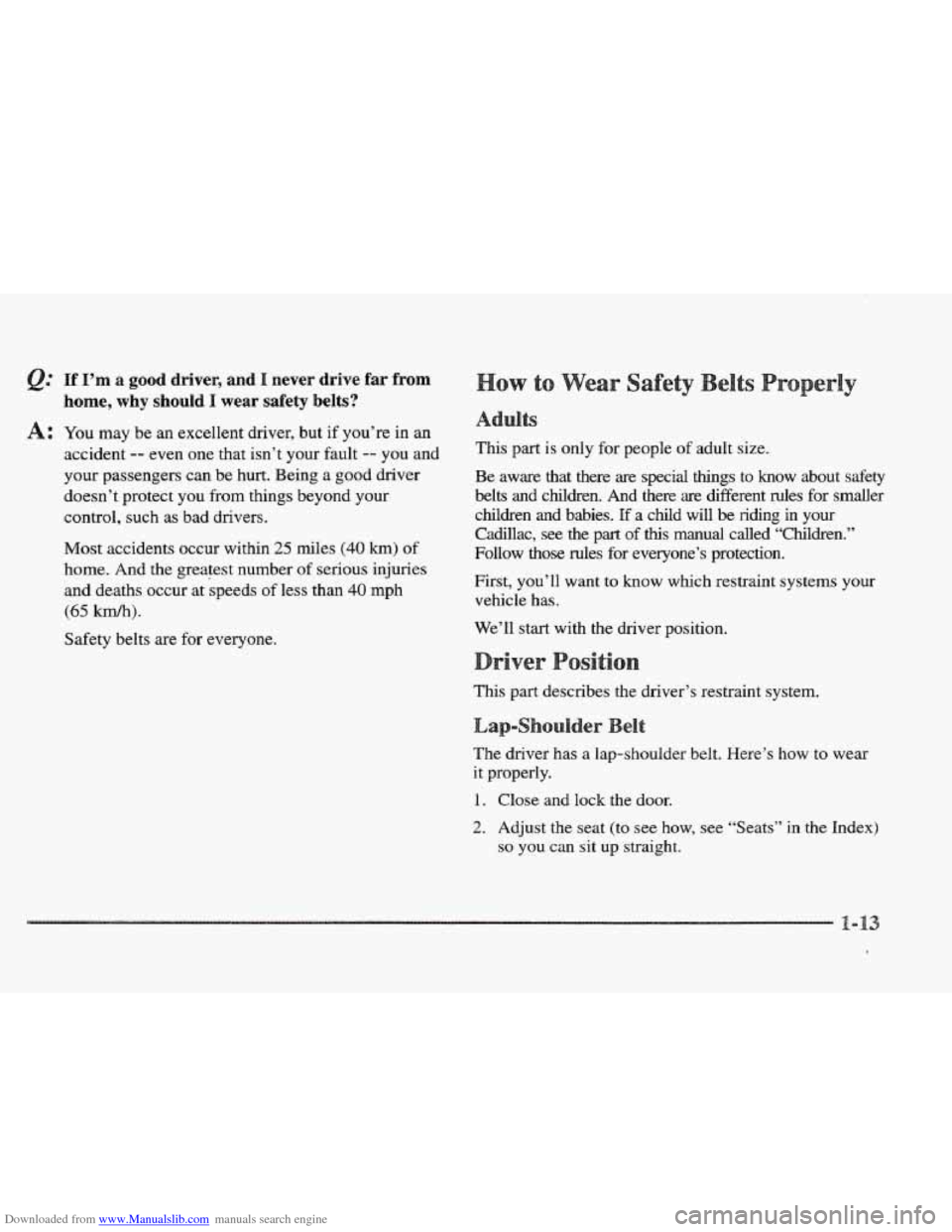
Downloaded from www.Manualslib.com manuals search engine : If I’m a good driver, and 1 never drive far from
home, why should I wear safety belts?
A You may be an excellent driver, but if you’re in an
accident
-- even one that isn’t your fault -- you and
your passengers can be hurt. Being
a good driver
doesn’t protect you from things beyond your
control, such as bad drivers.
Most accidents occur within 25 miles (40 km) of
home. And the greatest number of serious injuries
and deaths occur at speeds
of less than 40 mph
(65 kdh).
Safety belts are for everyone.
W Y Y
This part is only for people of adult size.
Be aware that there
are special things to know about safety
belts and children. And there
are different rules for smaller
children and babies.
If a child will be riding in your
Cadillac, see the
part of this manual called “Children.”
Follow those rules for everyone’s protection.
First, you’ll want to know which restraint systems your
vehicle has.
We’ll start with
the driver position.
This part describes the driver’s restraint system.
The driver has
a lap-shoulder belt. Here’s how to wear
it properly.
1. Close and lock the door.
2. Adjust the seat (to see how, see “Seats” in the Index)
so you can sit up straight.
Page 52 of 361
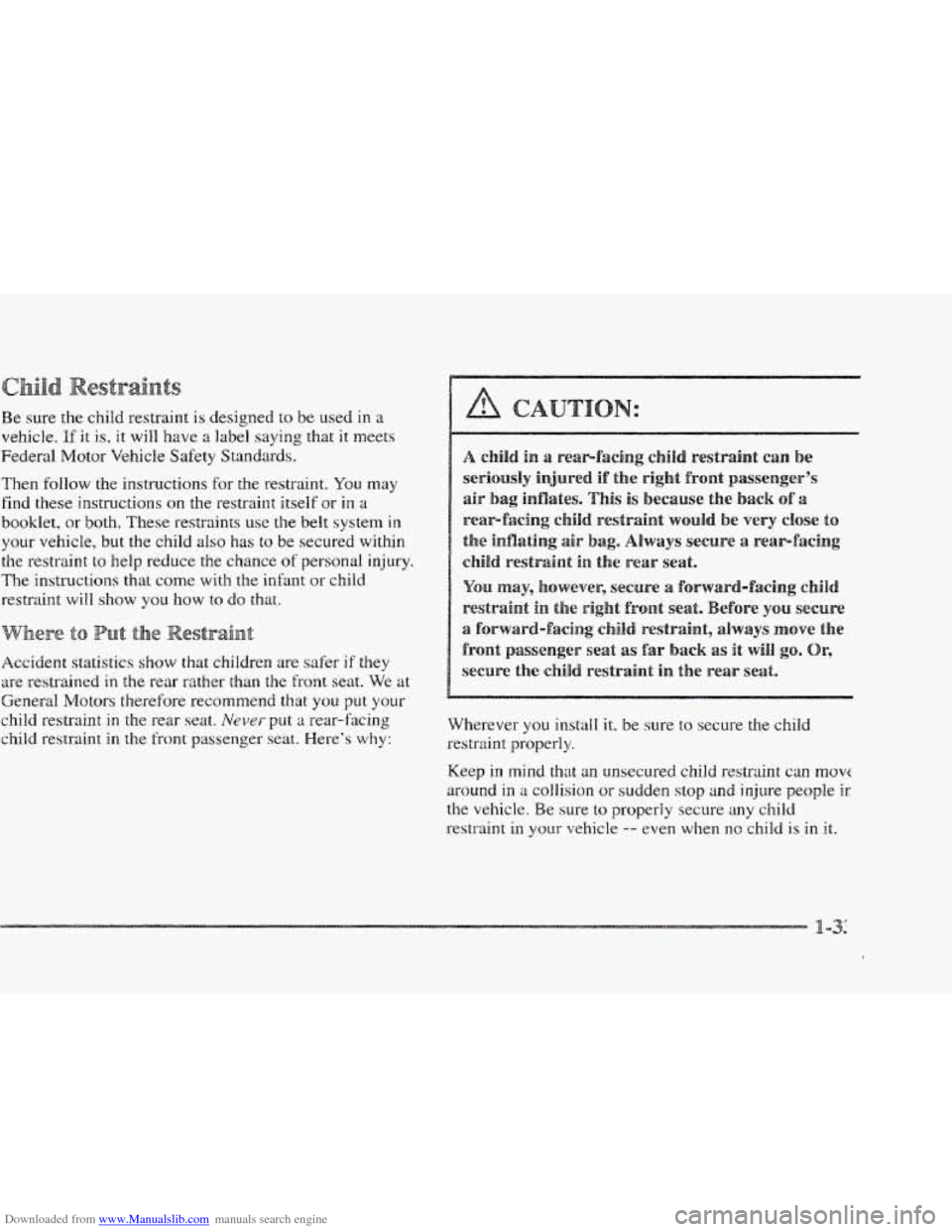
Downloaded from www.Manualslib.com manuals search engine s
Be sure the child restraint is designed to be used in a
vehicle. If it is, it will have a label saying that it meets
Federal Motor Vehicle Safety Standards.
Then follow the instructions for the restraint.
You may
find these instructions on the restraint itself
or in a
booklet, or both. These restraints use the belt system in
your vehicle, but the child also has to be secured within
the restraint
to help reduce the chance of personal injury.
The instructions that come with the infant or child
restraint
will show you how to do that.
Accident statistics
show that children are safer if they
are restrained
in the rear rather than the front seat. We at
General Motors therefore recommend that you put your
child restraint
in the rear seat. Never put a rear-facing
child restraint
in the front passenger seat. Here's why: Wherever
you install it, be
sure to secure the child
restrain1 properly.
Keep in mind that
an unsecured child restraint can mow
around
in a collision 0%' sudden stop and injure people ir
the vehicle. Be sure to properly secure any child
restraint
in yo~ar vehicle -- even when no child is in it.
Page 53 of 361
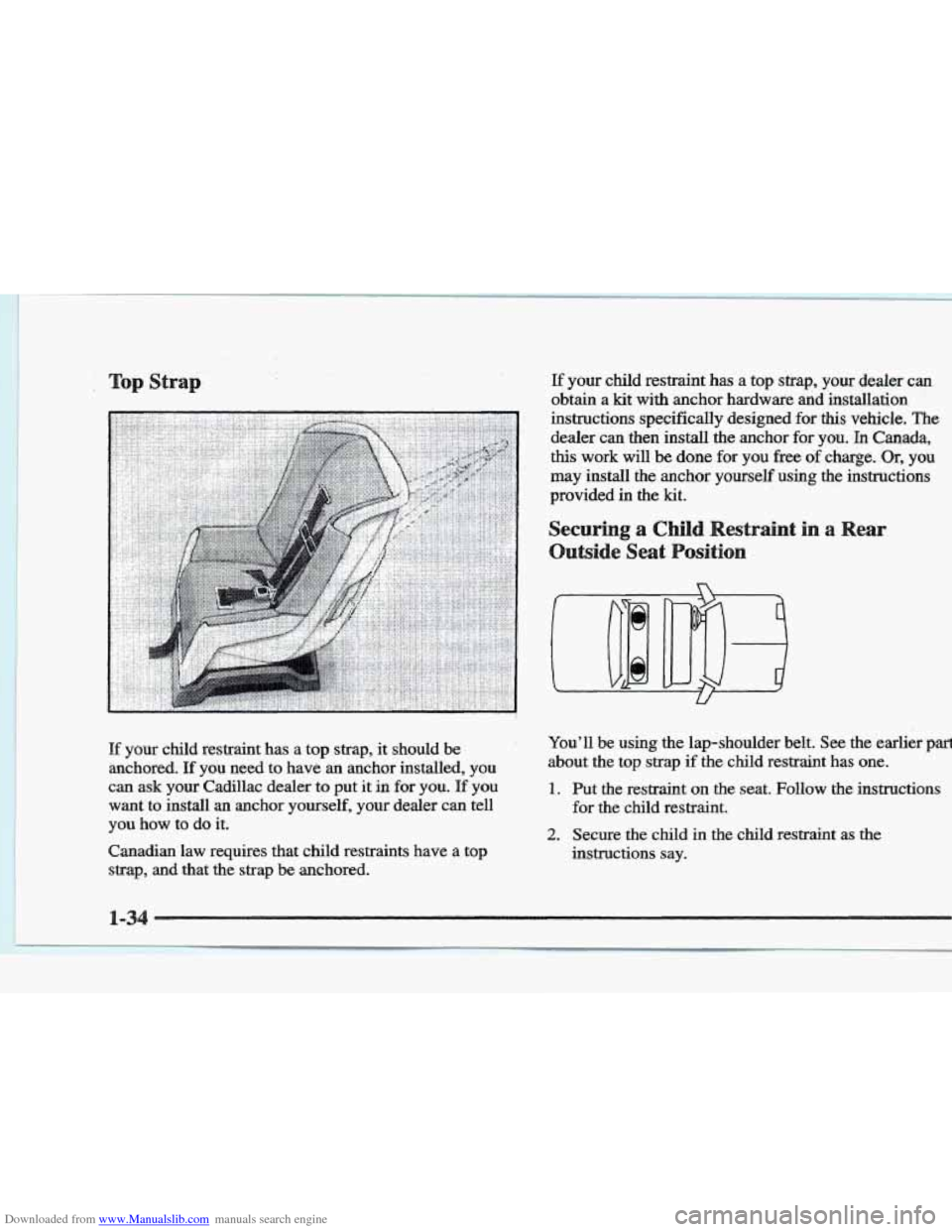
Downloaded from www.Manualslib.com manuals search engine If your child restraint has a top strap, your dealer can
obtain a kit with anchor hardware and installation
instructions specifically designed
for this vehicle. The
dealer can then install the anchor for you. In Canada,
this work will be done for you free of charge. Or, you
may install the anchor yourself using the instructions
provided
in the kit.
Securing a Child estraint in a
Outside Seat Position
If your child restraint has a top strap, it should be
anchored.
If you need to have an anchor installed, you
can
ask your Cadillac dealer to put it in for you. If you
want to install an anchor yourself, your dealer can tell
you
how to do it.
Canadian law requires that child restraints have a top
strap, and that the strap be anchored. You’ll be using the lap-shoulder belt. See
the earlier part
about the top strap if
the child restraint has one.
1. Put the restraint on the seat. Follow the instructions
for the child restraint.
2. Secure the child in the child restraint as the
instructions say.
Page 56 of 361
Downloaded from www.Manualslib.com manuals search engine 1.
2.
3.
4.
Make the belt as long as possible by tilting the latch
plate
and pulling it along the belt.
Put the restraint on the seat. Follow the instructions
for the child restraint.
Secure the child in the child restraint as
the
instructions say.
Run the vehicle’s safety belt through or around the
restraint. The child restraint instructions
will show
you how.
5. Buckle the belt. Make sure the release button is
positioned
so you would be able to unbuckle the
safety belt quickly
if you ever had to.
6. To tighten the belt, pull its free end while you push
down on the child restraint.
7. Push and pull the child restraint in different
directions to be sure it
is secure. If it isn’t, secure tlr
restraint in a different place in the vehicle and
contact the child restraint maker
for their advice
about how
to attach the child restraint properly.
Page 57 of 361
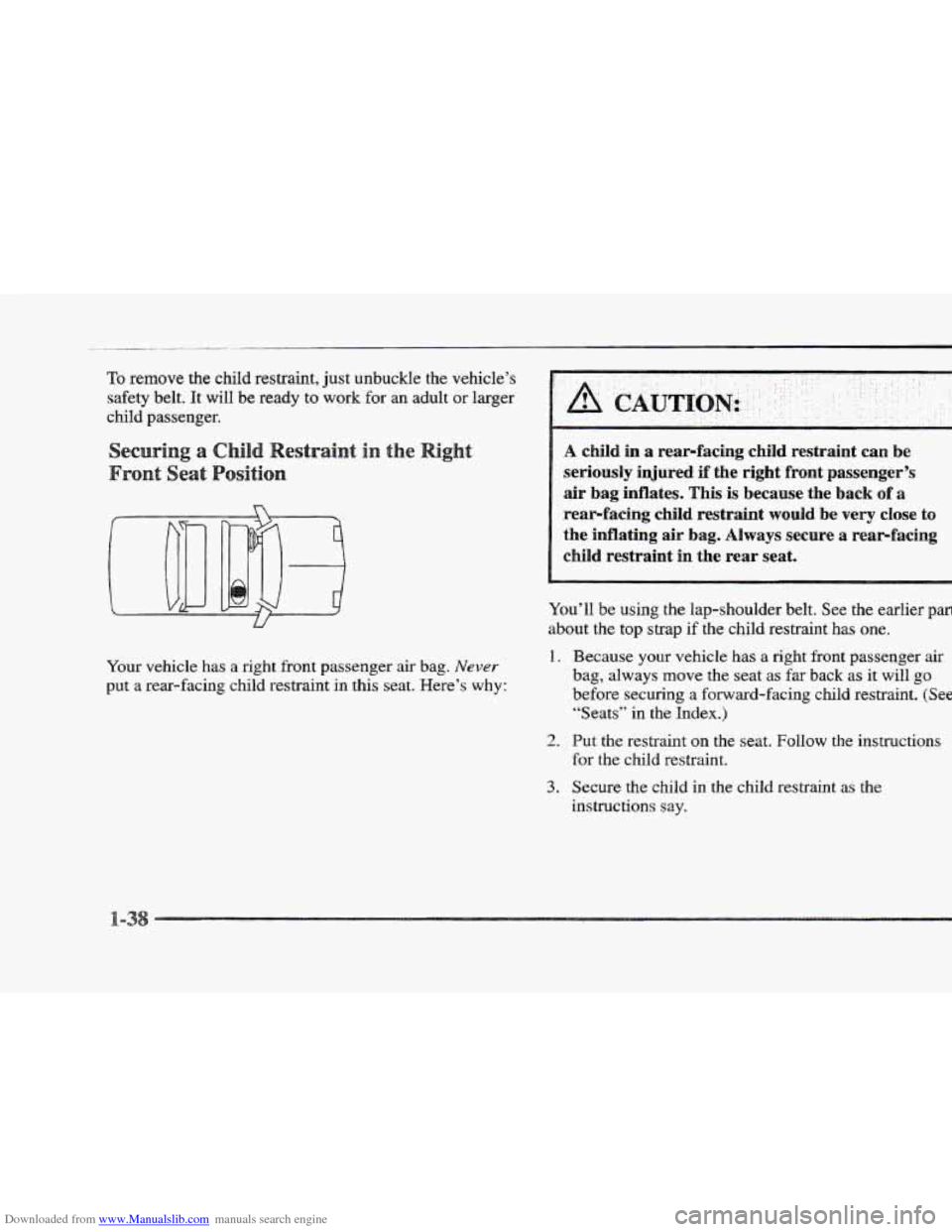
Downloaded from www.Manualslib.com manuals search engine To remove the child restraint, just unbuckle the vehicle’s
safety belt. It will be ready to work for
an adult or larger
child passenger.
Your vehicle has
a right front passenger air bag. Never
put a rear-facing child restraint in this seat. Here’s why:
A child in a rearfacing child restraint can be
seriously injured if the right front passenger’s
air bag inflates. This is because the back
of a
rear-facing child restraint would be very close to
the inflating air bag. Always secure a rearfacing
child restraint in the rear seat.
You’ll be using the lap-shoulder belt. See the earlier part
about the top strap if the child restraint has one.
1. Because your vehicle has a right front passenger air
bag, always move the seat as
far back as it will go
before securing a forward-facing chld restraint. (See
“Seats” in the Index.)
2. Put the restraint on the seat. Follow the instructions
for the child restraint.
3. Secure the child in the child restraint as the
instructions say.
Page 60 of 361
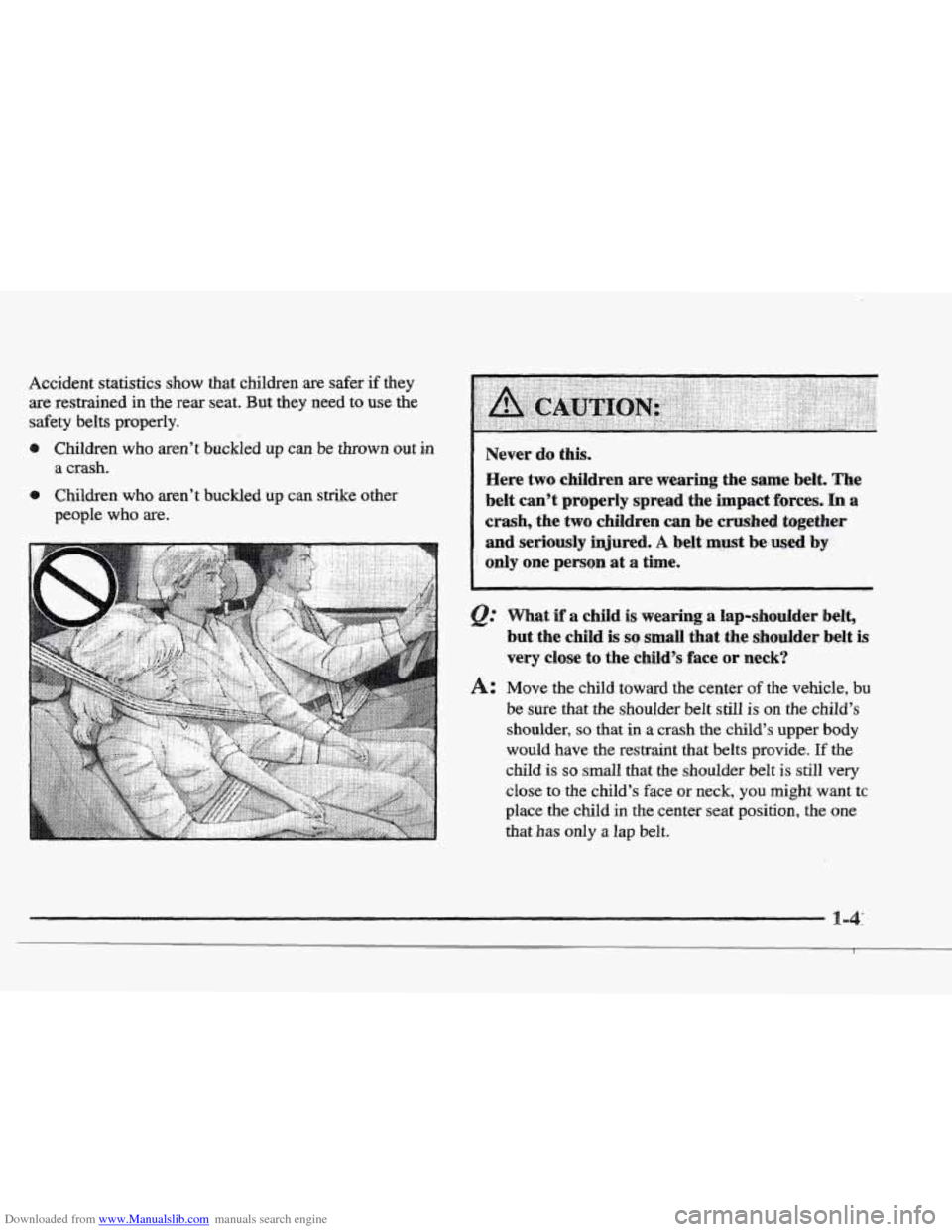
Downloaded from www.Manualslib.com manuals search engine Accident statistics show that children are safer if they
are restrained in the rear seat. But they need to use the
safety belts properly.
e Children who aren’t buckled up can be thrown out in
0 Children who aren’t buckled up can strike other
a crash.
people
who are.
Never do this.
Here two children are wearing the same belt. The
belt can’t properly
spread the impact forces. In a
crash, the
two children can be crushed together
and seriously injured. A belt must be used by
only one person at a time.
~~~~~ ~. ~
@ What if a child is wearing a lap-shoulder belt,
but the child
is so .small that the shoulder belt is
very close to the child’s face or neck?
A: Move the child toward the center of the vehicle, bu
be sure that the shoulder belt still is on the child’s
shoulder, so that in a crash the child’s upper body
would have the restraint that belts provide.
If the
child is so small that the shoulder belt is still very
close to the child’s face or neck, you might want tc
place the child
in the center seat position, the one
that has
only a lap belt.
I
Page 61 of 361
Downloaded from www.Manualslib.com manuals search engine _. .. , . ,
Never do this.
Here a child
is sitting in a seat that has a
lap-shoulder belt, but the shoulder part
is behind
the
child. If the child wears the belt in this way, in
a crash the child might slide under the belt. The
belt’s force would then be applied right on.the
child’s abdomen. That could cause serious or
fatal injuries.
Wherever the child sits, the lap portion of the belt
should be
worn low and snug on the hips, just touching
the child’s thighs. This applies belt force to the child’s
pelvic bones in a crash.